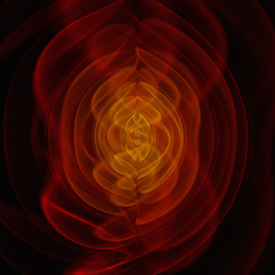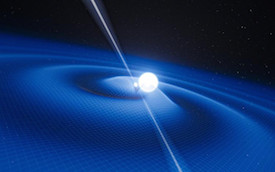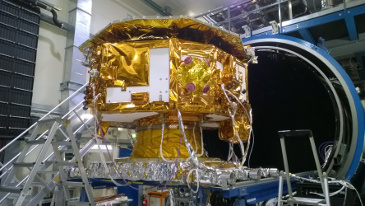Paving the way for gravitational-wave observatories in space
 |
| Gravitational waves released when two supermassive black holes merge. Credit: NASA/C. Henze |
(Update 12 February 2016: high-frequency gravitational waves, emitted by a pair of merging black holes, were directly detected for the first time with the Advanced Laser Interferometer Gravitational-Wave Observatory.)
During the past half-century, numerous ground-based experiments have searched for these cosmic ripples, so far without success. Modern detectors use laser beams to monitor tiny changes in the length of two perpendicular arms, each extending up to several kilometres. Variations in the length of the two arms could be caused by a variety of phenomena on Earth, both natural and artificial, but also by the passage of a gravitational wave.
The most sensitive gravitational-wave detectors are currently the pair of Laser Interferometer Gravitational-Wave Observatory (LIGO) in the United States. Recently upgraded, it started operations as Advanced LIGO in September 2015. Other detectors are the Virgo interferometer, operated by the European Gravitational Observatory in Italy, GEO600 in Germany, and KAGRA in Japan.
Like light, gravitational waves should span a wide range in frequencies (or wavelengths). Different types of astrophysical objects are expected to emit in different regions of this gravitational-wave spectrum.
A supernova explosion or the coalescence of a pair of orbiting stellar remnants, such as neutron stars or black holes, are sources of high-frequency gravitational waves (over 1 Hz). In contrast, the merging of supermassive black holes in large galaxies would be a source of low-frequency gravitational waves (between 0.1 and 0.0001 Hz). Gravitational waves at even lower frequencies (around 10-16 Hz) may also exist. If so, they would have been produced during inflation, a theorised phase of accelerated expansion in the first moments of the Universe.
 |
| A binary system consisting of a white dwarf and a pulsar orbiting each other. Credit: ESO/L. Calçada |
Different instruments will be needed to detect the full spectrum of gravitational waves. Ground-based experiments are sensitive to high frequencies, while observatories in space would be able to catch lower frequencies. The extremely-low-frequency gravitational waves from the early Universe would imprint their signature on the cosmic microwave background.
In space, a gravitational-wave observatory could use laser beams on a much longer baseline than between any pair of locations on Earth, making it sensitive to lower frequency gravitational waves. And, it would not be affected by the nuisance vibrations near the surface of Earth that plague ground-based detectors.
LISA Pathfinder is a new breed of spacecraft, testing technology to extend the quest for gravitational waves to space.
 |
| The LISA Pathfinder science module at the IABG test centre. Credit: ESA - J. Huesler |
It called for a profound change of mind-set. It is not a spacecraft carrying a suite of instruments but one single integrated system, with the payload controlling the movement of the satellite. Building it was a great engineering challenge and operating it will be equally testing. Its goal is to provide the gravitational-wave community with the confidence needed to build the first gravitational-wave observatory operating in space.
Future space-borne observatories will be able to explore the Universe to distances and epochs that cannot be accessed even with the most sensitive telescopes operating today. They will yield information about the distribution of matter and the formation of cosmic structure a mere hundred million years after the Big Bang.
However, the most exciting findings from the study of gravitational waves might be the discovery of new celestial objects and phenomena.

